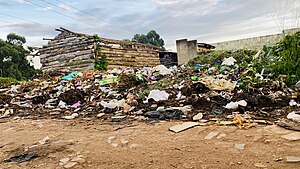
All carbon-based waste is a potential source of energy, through biogas, waste to oil, gasification or turning it into briquettes to burn in an improved cook stove or heater. Waste vegetable oil can be used as fuel for diesel vehicles directly, although it is more viscous than regular diesel and may damage engines. Biodiesel is a a fuel derived from filtering and refining used vegetable oil, and can be used as safe and effective source of energy with comparatively fewer CO2 emissions than regular diesel fuel. There is no such thing as garbage - only wasted resources.
Sewage be can a source of nutrients, which are lost when it is simply treated as a disposal problem. When this is done society loses on socioeconomic opportunity that it could otherwise benefit greatly from. After the energy is extracted with a biogas digester, the sludge can be used (with proper precautions) in agriculture. Composting toilets are another solution, which use drastically less water that conventional sewage systems and produce a greater bulk of rich compost compared to the biogas digester, but do not produce energy.
The idea that "there is no such thing as waste" comes from the concept of circular economies, where every material can be reused, repurposed, or recycled. In nature, waste does not exist—organic matter decomposes and returns nutrients to the soil, supporting new life. Humans can emulate this model by ensuring that resources are used efficiently and that nothing is thrown away unnecessarily.
The Circular Economy Model[edit | edit source]
A circular economy is one where products and materials are kept in use for as long as possible. Instead of a linear economy, where goods are produced, used, and discarded, a circular economy emphasizes reusing, recycling, and refurbishing materials. This reduces the need for new resources and minimizes environmental harm.
Practical Applications of the "No Waste" Philosophy[edit | edit source]
- Upcycling: One way to implement the “no waste” philosophy is through upcycling, where waste materials are transformed into products of higher value. For example, discarded wood can be turned into furniture or art, reducing the need for new resources.
- Composting: Organic waste such as food scraps and yard waste can be composted to create nutrient-rich soil, reducing the need for chemical fertilizers and minimizing landfill waste.
- Industrial Symbiosis: In some industrial settings, waste from one process can become the input for another. For example, the heat generated from a factory could be used to warm nearby homes.
Global Efforts to Eliminate Waste[edit | edit source]
Countries and organizations around the world are adopting zero-waste policies. Sweden, for instance, has implemented waste-to-energy technologies where almost no household waste ends up in landfills. Instead, waste is used to produce heat and electricity, illustrating that even materials once considered waste have value.
Municipal waste is typically a mess of all kinds of resources:
- Miscellaneous items, e.g. items soiled with food.[1]
- There are also goods that contain many useful nutrients that are contaminated or otherwise tied up so as to inhibit their effective utilization. A common example of this household carpets. Here large concentrations of natural fibers are bonded with toxic glues and/or mixed with non-biodegradable synthetic fibers.
- One technique to remedy this problem is known as Product Stewardship. This involves the responsibly of a product's disposal, including the associated disposal cost, being put on the producer instead of the consumer. This is incentive to the producer to design products that can broken down in a manner that is cost effective, efficient, and more environmentally conscious.
- In future it may be practical to use paper and plastic items soiled with food in a waste to energy incinerator (SWERF - Solid Waste Energy Recycling Facility).
Industrial ecology[edit | edit source]
Industrial ecology is a practice of no waste in industry - every output is used in some way, rather than being allowed to become waste.
Waste Incineration[edit | edit source]
- Waste incineration is a processing method which allows for the energy contained within a waste product to be extracted and used. Incineration also allows for the total mass of solid waste to be reduced. This process involves the ignition of waste which is than allowed to burn, fueling a steam generator creating electricity. The gasses released from this process are then filtered to prevent contamination of toxic waste into the environment.
- Currently Sweden is importing waste from neighboring countries to fuel their incinerators. This action has been actively protested against by Greenpeace, in the belief that the filters do not remove dioxin, which is known to be carcinogenic in humans.
See also[edit | edit source]
External links[edit | edit source]
- Waste for Life, a loosely joined network of scientists, engineers, educators, designers, and cooperatives working together to develop poverty-reducing solutions to specific ecological problems.
- Ellen MacArthur Foundation
- Zero Waste Europe
Notes[edit | edit source]
- ↑ Can the householder can tell what is suitable for recycling and what isn't? A guide to household recycling, with pictures and authoritative information, would be very helpful.[expansion needed]